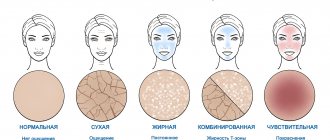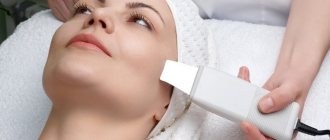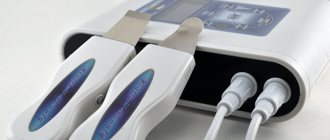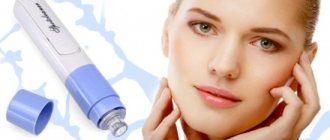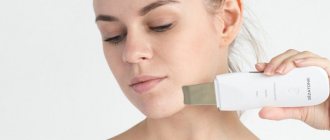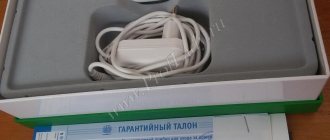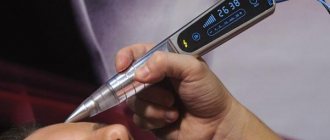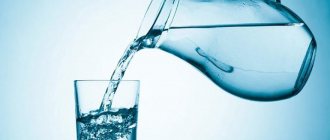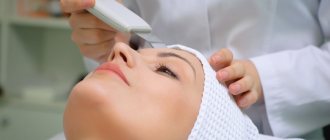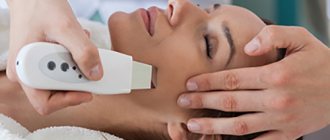From this article you will learn:
- Operating principle of ultrasound
- Indications and contraindications for ultrasound treatment
- Types of ultrasound procedures and their features
- Cost of ultrasound procedures
Various types of ultrasound procedures are in high demand among modern girls. The thing is that ultrasound is actively used in cosmetology and allows you to eliminate problems with facial skin and more.
Thanks to an ultrasound machine, you can also get rid of cellulite, scars and scars, and improve hair health. Why ultrasound therapy is so effective, what indications and contraindications exist for such treatment, we will tell you in our article.
Cleansing facial skin. Why is it important?
We often hear that any skin care begins with cleansing.
Why is this so? Renewal of the epidermis (upper layer of skin) occurs throughout life. Young cells formed in the lower layers gradually rise up, die (keratinize), slough off and separate from the skin. Due to a whole range of factors (age, stress, environment, eating modern foods, etc.), this process slows down, and the skin does not have time to completely get rid of all dead cells. They remain on its surface, mixed with secretions of the sebaceous glands (sebum), particles of makeup and dust. This creates a dense layer of impurities that cannot be dissolved by conventional cleansers.
Skin with such a “shell” feels bad:
- All its functions are disrupted, and the process of natural renewal is slowed down even more. It loses its healthy color, looks dull and “tired”, its quality deteriorates;
- Pollution clogs pores, leading to the appearance of “blackheads” (comedones) and blackheads;
- The active ingredients in cosmetics cannot penetrate deep into the skin in sufficient quantities.
The keratinized epidermis, which cannot “come off” from the surface, looks like peeling. We begin to think that the skin is dry, we heavily use moisturizing and nourishing products - but this only causes dead cells to swell, and flaking becomes even more noticeable. Sound familiar?
Contraindications
Ultrasound therapy, contraindications to which depend on a number of factors, are divided into two categories:
- Absolute, which include:
- tendency to bleed;
- benign tumors with a threat of degeneration;
- feverish states, convulsions and paralysis;
- pathologies of the circulatory system;
- infectious diseases in acute stages;
- malignant formations.
- Relative, including diseases of systems and organs in the last degree, as well as exacerbations of chronic diseases. This group also includes:
- active stage of tuberculosis;
- severe endocrine disorders;
- diabetes;
- atherosclerosis;
- hypertension 3-4 degrees;
- pregnancy.
In the case of relative contraindications, it is recommended to consult a specialist who, based on an assessment of the overall clinical picture, will determine whether the use of UST is possible in each specific case.
Ultrasonic facial cleansing. How it works?
Ultrasonic cleansing (Ultrasonic peeling) is a method of deep cleansing the face based on the action of ultrasonic waves.
Our skin is regularly renewed throughout our lives. The top layer (epidermis) consists of several rows: new cells are formed at the border with the dermis and gradually move upward, being replaced by younger ones. On the surface, epidermal cells become keratinized, gradually die, desquamate and separate from the skin.
With age, the skin loses its strength, and this process slows down. The rate of cell renewal is also influenced by many external and internal factors (ecology, nutrition, lifestyle, bad habits, etc.). The keratinized epidermis does not have time to separate completely. Dead cells mix with secreted sebum and toxins, dust particles from the air, and makeup residues. As a result, a rather dense layer of impurities forms on the surface of the skin, which does not allow it to breathe freely, secrete, or absorb useful cosmetics in the required quantity. This “shell” further worsens the condition of the skin and slows down the renewal of its cells.
Deep cleansing and light peelings help break the vicious circle. Ultrasound peeling is one of the simplest and most productive.
Effect of ultrasonic facial cleansing:
Small frequent vibrations of ultrasonic waves, invisible to the human eye, break the connections between cells with impaired metabolism, helping the skin get rid of keratinized scales and impurities on its surface
Ultrasonic vibration mechanically “knocks out” deeper impurities and sebaceous gland production from the skin pores. The procedure prevents the formation of comedones - dense clots from a mixture of sebum, particles of keratinized epidermis and dust settling on the face, which can subsequently become inflamed, turning into acne.
In addition, ultrasound has a triple effect on cells:
- Thermal consists of a local increase in temperature by 1-2 degrees, which causes an acceleration of metabolic processes;
- Mechanical compression and stretching of cells, as a result of which the permeability of cell membranes increases;
- Physico-chemical is associated with the restructuring of intracellular structures, stimulation of the synthesis of enzymes and the production of collagen, elastin, hyaluronic acid.
The procedure is very simple, painless and does not injure the skin in any way.
Mechanism of Ultrasound Therapy
Currently, several mechanisms of the influence of ultrasound on the human body are known, which relate to the primary mechanisms of ultrasound.
Among them:
- Thermal – providing for the transition of ultrasonic waves into heat after they are absorbed by tissues. This leads to an increase in their temperature by about one degree. At this time, the activity of enzymes inside cells and biochemical reactions increase. Heat appears exclusively at the boundaries of tissues that have different densities. Thermal energy is absorbed to a greater extent by organs in which there is a lack of blood flow and saturation with collagen fibers, as well as nerve and bone tissue.
- Mechanical – which is based on high-frequency vibrations transmitted to tissues. At this moment, a vibration elusive to humans occurs, provoking an acceleration of blood circulation and an increase in cellular metabolism. The vibration effect helps to liquefy the cytoplasmic fluid, accelerate the diffusion of microelements, and also loosen connective tissues. All this increases the metabolic rate. When high-frequency waves are applied, an increase in the degree of permeability of histohematic barriers is observed.
- Physico-chemical - provoked by mechanical resonance and contributing to an increase in the speed of movement of molecular structures. This type of impact accelerates the breakdown of molecules into ions, resulting in the formation of new electric fields. Lipids are oxidized faster, the functioning of mitochondrial cellular structures is optimized. These and many other processes, activated under physicochemical influence, contribute to the rapid restoration of tissues.
The use of ultrasound therapy is directly related to the effect it has on tissue:
- The creation and release of thermal energy provokes an improvement in biochemical reactions and diffusion processes, and also stimulates microcirculation and the production of substances that the body needs.
- Micro-massage, which appears as a result of the action of a mechanical wave, sets in motion the fluid located inside and outside the tissues, increases the metabolic rate and improves the functioning of organs.
Problems for which ultrasonic peeling is recommended:
- The skin has lost its healthy appearance, the complexion is dull;
- Pores are enlarged, contaminated, there are “black spots”;
- Signs of withering, aging skin;
- Shallow wrinkles on the face, neck and décolleté;
- Hypersecretion of the sebaceous glands, oily skin prone to rashes;
- Peeling, increased dry skin, seborrhea;
- Decreased elasticity, tone, sagging skin.
Ultrasonic peeling is indicated for skin of any type for deep cleansing and prevention of premature aging. Loose skin has higher immunity and easily resists various types of damage.
How often should I do it?
There are contraindications.
Consult your doctor. In order for the ultrasonic facial cleansing procedure to be most effective, it is necessary to undergo a whole course of such sessions. A single procedure will not bring tangible changes. A cosmetologist will be able to determine the number of sessions for you, who, based on the results of examining the condition of the skin and the degree of existing contamination, will prescribe the necessary course of therapy. Most often, for oily skin prone to acne formation, at least 5-6 cleansing procedures are required, carried out at intervals of 7-10 days, then maintenance therapy sessions are carried out once every two months. Dry skin can be tidied up in 2-3 procedures, which you will be asked to undergo at intervals of 14 days. Further maintenance sessions are carried out once every three months.
The procedure, performed under appropriate conditions by a competent specialist, does not result in any negative consequences. When applying for a service, pay attention to contraindications for its implementation, and also take into account the serviceability of the device and the qualifications of the specialist. However, even if all norms and precautions are observed, the possibility of an individual negative reaction of the body still exists. A negative reaction to the procedure may manifest itself as follows:
- swelling of the face;
- slight pain with increased skin sensitivity;
- areas of redness, lumpy skin.
As a rule, these effects go away on their own within a few hours.
If the symptoms progress, then in this case qualified medical assistance will be required, which is best sought immediately.
Results of ultrasonic facial cleansing:
- The surface of the skin is cleansed, particles of impurities are “knocked out” from the pores;
- Microcirculation improves, blood vessels are strengthened: increased blood supply nourishes cells, and stimulation of lymphatic drainage accelerates the removal of toxins, prevents the formation of fluid stagnation and swelling;
- The number of comedones and inflammations, unhealthy greasy shine is reduced;
- The microrelief of the skin is evened out: small wrinkles are smoothed out, scars and post-acne scars (especially fresh ones) become less noticeable;
- Enlarged pores narrow, new ones practically do not appear;
- The skin becomes firmer and more elastic, its tone increases;
- The complexion improves, the skin acquires a healthy glow, looks fresh, becomes incredibly smooth and soft;
- The feeling of discomfort on the face disappears.
What additional functions are available in ultrasonic facial cleansing devices?
Many portable ultrasound devices have additional functions that significantly expand the list of cosmetic procedures “for home”. Therefore, before choosing an ultrasound machine, you must first study its capabilities.
Phonophoresis
Deep delivery of active cosmetics nutrients into the deep layers of the skin using ultrasound. Ultrasound waves, causing compression of cells, create temporary channels in the epidermis. Through them, even fairly large molecules of active ingredients of cosmetics penetrate into the skin, which are not able to overcome the epidermal barrier with conventional surface application. The effect of non-injection mesotherapy is created when beneficial substances accumulate deep in the skin in high concentration and are gradually released from such a depot, directly acting from the inside on the cells of the deep layer of the epidermis and dermis
Ultrasonic micromassage
Small mechanical vibrations cause alternating contraction and stretching of cell membranes, increasing their permeability to useful substances.
Therefore, phonophoresis and micromassage procedures are recommended to be carried out together, after ultrasonic cleaning. The complex effect of ultrasonic vibrations and special cosmetic products increases the activity of the drugs, promotes their deep penetration, lengthening the duration of action, and reducing adverse reactions.
Iontophoresis
It is possible when the device generates galvanic currents that conduct deep into positively or negatively charged particles (ions) from special cosmetics. It is known that differently charged particles are strongly attracted to each other, and equally charged ones are also strongly repelled. Thus, a negative electrode will “push” negative ions (-) into the skin to a depth of 1.5 cm, and a positive electrode will push (+) ions. Being in the deep layers of the skin, ions accumulate on the surfaces of cell membranes and are absorbed more easily and quickly (compared to ordinary particles), because many active elements inside cells exist in this form.
Disincrustation
Cleansing comedones with galvanic currents, which cause a chemical reaction between special disincrustation agents and fatty acids in sebum. During exposure, the usually acidic environment of the skin changes to the alkaline side, fatty acids are destroyed and turned into ordinary soap, which is easily washed out of the pores. In this way, you can free the skin even from very dense and very deep sebaceous plugs.
Galvanic lifting
Another positive effect of galvanic currents. When using specially developed anti-aging cosmetics with ions, noticeable thickening and tightening of the skin occurs.
Brushing
Mechanical cleansing of surface dirt and makeup residues with special brushes. Recommended for daily thorough washing. Some ultrasound devices are equipped with special silicone brush attachments with delicate bristles, which allow you to save on the purchase of a separate device and use the ultrasound scrubber every day.
Microcurrents
Exposure to weak pulsed electric currents with special characteristics leads to increased skin activity at the cellular level. Their energy potential increases (ATP synthesis - the main source of cell nutrition), ion channels open, metabolism, protein and DNA synthesis accelerates. Each skin cell “wakes up” and begins to function more actively, and the duration of its life cycle increases.
Chromotherapy
Positive effects on the skin of light rays of different lengths.
So the best facial cleanser is sure to be multifunctional.
How to care for your skin after cleansing?
After the skin has been exposed to an ultrasound cleaning device, it needs maintenance care. Ultrasonic peeling does not damage, but dries the skin, which is very good for the epidermis, which is prone to greasiness. However, after the manipulation, the skin should be pampered with moisturizing creams, serums, and regenerating masks. It is better to choose cosmetics from the “sensitive skin” segment.
To ensure that the effect of the procedure lasts as long as possible, treat your skin with care and attention:
- use sunscreen (SPF at least 20);
- within 24 hours after cleaning, do not visit the solarium, beach, sauna, or gym;
- Do not use decorative cosmetics for 24 hours;
- cleanse the skin using gentle products;
- replace cosmetics containing alcohol with alcohol-free analogues;
- drink more clean water.
Violation of the technique, time or intensity of the procedure may negatively affect the condition of your
What cosmetics should I use for ultrasonic facial cleansing?
In addition to choosing the best device for ultrasonic cleaning, you should think about buying cosmetics for the procedures.
- A special gel that conducts ultrasonic waves deep into the skin. Without it, they will simply fade on a dry surface and no cleaning will be possible. Such products always contain a whole range of active substances to solve various skin problems, so when choosing, you should pay attention to this;
- Special products designed for phonophoresis and ultrasonic micromassage. Any serum will not work: many substances are destroyed under the influence of ultrasound;
- Gels or disinfectant lotions for galvanic cleaning, if the device provides such a possibility;
- Active “charged” complexes for iontophoresis.
How to choose cosmetics for ultrasonic facial cleansing? Read our article for details!
READ
Ultrasonic facial cleansing technology: how the procedure is carried out
Unlike mechanical cleaning, the ultrasonic type does not require preliminary steaming of the skin. All you need to do is remove makeup and wash with regular skin cleansing products; in some cases, the cosmetologist will suggest preparing with “cold hydrogenation” - a procedure for applying a special preparation.
Next, the cosmetologist applies a special liquid to the skin - ultrasound gel, which improves the conductivity of ultrasound waves. With smooth, slow movements, the doctor moves a special metal spatula - an ultrasonic attachment - over the treated areas. In this case, the patient does not feel anything except the touch of the shoulder blade to the skin. In places where the skin is located close to the bone structures, slight vibration is felt. The working area of the tool is located at an angle of 35-45 degrees to the plane of the surface being processed.
The cleansing process itself lasts about 15-20 minutes. If creams, masks and other care products are applied, the duration of the session increases to 50-60 minutes.
How often can you do ultrasonic cleaning? Typically, professional cleaning by a cosmetologist requires no more than 3-4 sessions, between which an interval of 4-5 days should be observed. One procedure approximately once every 2-3 months allows you to maintain the effect obtained.
What are the contraindications for ultrasonic cleaning procedures?
The procedure cannot be done if you have:
- Injuries, cuts, burns, abrasions, as well as active pustular inflammation in the area of cleaning;
- Chronic diseases in the acute stage;
- Oncology;
- Diabetes;
- Mental disorders, epilepsy;
- Herpes in the acute stage, dermatitis, dermatoses;
- Pregnancy and lactation;
- Feverish conditions;
- Implants, reinforcement in the affected area;
- Neuralgia of the facial nerve;
- Pronounced rosacea.
Indications for ultrasound therapy
The UST method is applicable today in various medical fields in the treatment of a wide range of diseases. Among them are diseases of the cardiovascular system, including angina pectoris, ischemia, and hypertension. It is also indicated for patients with primary muscular atrophy, flaccid paralysis, injuries and diseases of the musculoskeletal system, gastrointestinal tract, cystitis, gynecological inflammation and prostatitis. UST has shown its effectiveness in the fight against vasospasm, pyelonephritis, trophic ulcers and pathologies of the upper respiratory tract.
The method is common in therapy:
- hernias;
- diseases of the spine;
- osteochondrosis;
- myalgia;
- neuritis;
- myositis.
It is also used for pinched nerves and joint inflammation.
Exposure to ultrasound leads to a decrease in the sensitivity of nerve receptors, and also optimizes the functioning of the autonomic nervous system and regulates the speed of transmission of nerve impulses. This was the reason that ultrasound therapy, the indications for which are determined by the doctor, has also shown its effectiveness in neurology, radiculitis, spinal injuries, neuropathy, multiple sclerosis and spinal cord injuries.
The ultrasonic wave treatment method is intensively used in the field of beauty. With its help, figure correction, peeling, hardware massage are carried out and various defects are eliminated:
- wrinkles;
- scarring;
- stretch marks and adhesions;
- hyperpigmentation;
- consequences of atopic dermatitis;
- skin inflammation;
- age-related degenerative skin changes.
How to choose an ultrasonic cleaning device?
Many stores offer portable ultrasound devices. How do you know which device is best for ultrasonic cleaning?
Pay attention to the following characteristics:
| Ultrasound frequency (wave vibrations) | The quality of the procedure directly depends on this indicator. Focus on the average value in professional devices - from 24 to 30 kHz (some home models generate ultrasonic waves with a frequency of 18-20 kHz) |
| Device power | It determines how deeply the waves can penetrate the skin. Normal value is from 0.5 to 2 W |
| Availability of additional functions | The device significantly expands its capabilities |
| Number of operating modes of the device | Allows you to select the most suitable level of exposure for your skin |
| Battery | Battery powered (without connection to the power supply) makes procedures as convenient as possible |
| Weight and size | These characteristics determine how comfortable it is to hold the device in your hand. |
| Safety and Certification | The certified device has passed all the necessary checks and tests, so you can be confident in its quality and safety |
| Quality of materials used | Cheap plastic can be toxic, and inexpensive metal coating will quickly deteriorate. No self-respecting manufacturer skimps on materials |
| Manufacturer brand awareness | No comments: this way you will definitely protect yourself from goods of dubious quality |
| Reviews from real customers | Speak for themselves |
What is ultrasound?
Ultrasound (US) is elastic vibrations and waves, the frequency of which is higher than 15...20 kHz. The lower limit of the ultrasonic frequency region, separating it from the region of audible sound, is determined by the subjective properties of human hearing and is conditional. The upper limit is due to the physical nature of elastic waves, which can propagate only in a material medium, that is, provided that the wavelength is significantly greater than the free path of molecules in gases or interatomic distances in liquids and solids. Therefore, in gases, the upper limit of ultrasonic frequencies is determined from the condition of approximate equality of the sound wavelength and the free path of molecules. At normal pressure it is 109 Hz. In liquids and solids, the determining factor is the equality of the wavelength to interatomic distances, and the cutoff frequency reaches 1012-1013 Hz. Depending on the wavelength and frequency, ultrasound has specific characteristics of radiation, reception, propagation and application, therefore the ultrasonic frequency range is conveniently divided into three sub-regions:
- low - 1.5–10...105 Hz;
- average - 105...107 Hz;
- high - 107...109 Hz.
Elastic waves with frequencies of 1·108…1·1013 Hz are commonly called hypersound.
Sound wave theory
Ultrasound as elastic waves
Ultrasonic waves by their nature do not differ from elastic waves in the audible range, as well as from infrasonic waves.
The propagation of ultrasound obeys basic laws common to acoustic waves of any frequency range, usually called sound waves. The basic laws of their propagation include the laws of reflection and refraction of sound at the boundaries of various media, diffraction and scattering of sound in the presence of obstacles and inhomogeneities in the medium and irregularities at the boundaries, and the laws of waveguide propagation in limited areas of the medium.
Specific features of ultrasound
Although the physical nature of ultrasound and the basic laws governing its propagation are the same as for sound waves of any frequency range, it has a number of specific features that determine its significance in science and technology. They are due to its relatively high frequencies and, accordingly, short wavelength.
Thus, for high ultrasonic frequencies the wavelengths are:
- in the air - 3.4⋅10-3...3.4⋅10-5 cm;
- in water - 1.5⋅10-2...1.5⋅10-4 cm;
- in steel - 1⋅10-2 ... 1⋅10-4 cm.
This difference in the values of ultrasonic waves (USW) is due to different speeds of their propagation in different media. For the low-frequency region, ultrasonic wavelengths do not exceed several centimeters in most cases and only reach several tens of centimeters in solids near the lower limit of the range.
Ultrasonic waves attenuate much faster than low-frequency waves, since the sound absorption coefficient (per unit distance) is proportional to the square of the frequency.
Another very important feature of ultrasound is the ability to obtain high intensity values at relatively small amplitudes of oscillatory displacement, since at a given amplitude the intensity is directly proportional to the square of the frequency. The amplitude of the oscillatory displacement in practice is limited by the strength of the acoustic emitters.
The most important nonlinear effect in an ultrasonic field is cavitation—the appearance in a liquid of a mass of pulsating bubbles filled with steam, gas, or a mixture of them. The complex movement of bubbles, their collapse, merging with each other, etc. generate compression pulses (microshock waves) and microflows in the liquid, causing local heating of the medium and ionization. These effects have an impact on the substance: destruction of solid bodies in the liquid occurs (cavitation erosion), various physical and chemical processes are initiated or accelerated (Fig. 1).
Rice. 1
By changing the conditions for cavitation, you can strengthen or weaken various cavitation effects. For example, with increasing ultrasonic frequency, the role of microflows increases and cavitation erosion decreases; with an increase in hydrostatic pressure in the liquid, the role of microimpact influences increases. An increase in frequency usually leads to an increase in the threshold intensity value corresponding to the onset of cavitation, which depends on the type of liquid, its gas content, temperature, etc. For water in the low-frequency ultrasonic range at atmospheric pressure, it is usually 0.3-1 W/cm3.
Ultrasound sources
In nature, ultrasound is found in many natural noises (in the noise of wind, waterfall, rain, in the noise of pebbles rolled by the sea surf, in the sounds accompanying lightning discharges, etc.), as well as in the world of animals that use it for echolocation and communication.
Technical ultrasound emitters used in the study of ultrasound and their technical applications can be divided into two groups. The first includes emitter-generators (whistles). Oscillations in them are excited due to the presence of obstacles in the path of a constant flow - a stream of gas or liquid. The second group of emitters are electroacoustic transducers: they convert already given electrical vibrations into mechanical vibrations of a solid body, which emits acoustic waves into the environment.
Ultrasound Applications
The diverse applications of ultrasound, in which its various features are used, can be divided into three areas. The first is associated with obtaining information through ultrasound, the second with the active influence on matter, and the third with the processing and transmission of signals (the directions are listed in the order of their historical development).
Principles of ultrasonic cleaning
The main role in the influence of ultrasound on substances and processes in liquids is played by cavitation. The most widely used ultrasonic technological process, the cleaning of solid surfaces, is based on cavitation. Depending on the nature of the contaminants, various manifestations of cavitation, such as micro-impact effects, micro-flows, and heating, may be of greater or lesser importance. By selecting the parameters of the sound field, the physicochemical properties of the washing liquid, its gas content, and external factors (pressure, temperature), it is possible to control the cleaning process within a wide range, optimizing it in relation to the type of contaminants and the type of parts being cleaned. A type of cleaning is etching in an ultrasonic field, where the action of ultrasound is combined with the action of strong chemical reagents. Ultrasonic metallization and soldering are actually based on ultrasonic cleaning (including removal of oxide film) of the surfaces being joined or metallized. Cleaning during soldering (Fig. 2) is caused by cavitation in the molten metal. The degree of purification is so high that compounds are formed that cannot be soldered under normal conditions, for example, aluminum with other metals, various metals with glass, ceramics, and plastics.
Rice. 2
In the processes of cleaning and metallization, the sound-capillary effect is also essential, ensuring the penetration of the cleaning solution or melt into the smallest cracks and pores.
Cleaning and washing mechanisms
Cleaning in most cases requires that contaminants be dissolved (in the case of dissolved salts), scraped off (in the case of insoluble salts), or both dissolved and scraped off (as in the case of insoluble particles embedded in a layer of fatty films). The mechanical effects of ultrasonic energy can be useful in both accelerating dissolution and separating particles from the surface being cleaned. Ultrasound can also be used effectively in the rinsing process. Residual chemicals from cleaning media can be quickly removed by ultrasonic rinsing.
When removing contaminants by dissolution, the solvent must come into contact with the contaminating film and destroy it (Fig. 3, a). As the solvent dissolves the contaminant, a saturated solution of the contaminant in the solvent appears at the solvent–contamination interface, and dissolution stops because there is no delivery of fresh solution to the surface of the contaminant (Fig. 3b).
Rice. 3
Exposure to ultrasound destroys the layer of saturated solvent and ensures the delivery of fresh solution to the surface of the contamination (Fig. 3, c). This is especially effective in cases where “irregular” surfaces with a labyrinth of sinuses and surface relief, such as printed circuit boards and electronic modules, are subject to cleaning.
Some contaminants are a layer of insoluble particles firmly adhered to the surface by forces of ionic bonding and adhesion. These particles only need to be separated from the surface to break the forces of attraction and transfer them into the volume of the washing medium for subsequent removal. Cavitation and acoustic currents tear off contaminants such as dust from the surface, wash them away and remove them (Fig. 4).
Rice. 4
Contaminants, as a rule, are multicomponent and may contain soluble and insoluble components in combination. The effect of ultrasound is that it emulsifies any components, that is, it transfers them into the washing medium and, together with it, removes them from the surface of the product.
To introduce ultrasonic energy into the cleaning system, an ultrasonic generator, a converter of the generator's electrical energy into ultrasonic radiation, and an acoustic power meter are needed.
An electric ultrasonic generator converts electrical energy from the network into electrical energy at an ultrasonic frequency. This is done by known methods and does not have any specifics. However, it is preferable to use digital generation technology, when the output produces rectangular pulses of alternating polarity (Fig. 5). The efficiency of such generators is close to 100%, which makes it possible to solve the problem of the energy intensity of the process. Using a square wave signal results in acoustic emissions rich in harmonics. The advantages of a multi-frequency cleaning system are that no “dead” zones are formed in the interference nodes in the volume of the washing medium. Therefore, multi-frequency ultrasonic irradiation makes it possible to locate the cleaning object in almost any zone of the ultrasonic bath.
Rice. 5
Another technique for getting rid of “dead” zones is to use a frequency-swinging generator (Fig. 6). In this case, the nodes and antinodes of the interference field move to different points of the cleaning system, without leaving any areas for cleaning without irradiation. But the efficiency of such generators is relatively low.
Rice. 6
There are two general types of ultrasonic transducers: magnetostrictive and piezoelectric. They both perform the same task of converting electrical energy into mechanical energy.
Magnetostrictive converters (Fig. 7) use the magnetostriction effect, in which some materials change linear dimensions in an alternating magnetic field.
Rice. 7
The electrical energy from the ultrasonic generator is first converted by the magnetostrictor winding into an alternating magnetic field. The alternating magnetic field, in turn, generates mechanical vibrations of ultrasonic frequency due to the deformation of the magnetic circuit in time with the frequency of the magnetic field. Since magnetostrictive materials behave like electromagnets, the frequency of their deformation oscillations is twice as high as the frequency of the magnetic, and therefore the electric, field.
Electromagnetic converters are characterized by an increase in energy losses due to eddy currents and magnetization reversal with increasing frequency. Therefore, powerful magnetostrictive transducers are rarely used at frequencies above 20 kHz. Piezo transducers, on the contrary, can radiate well in the megahertz range. Magnetostrictive transducers are generally less efficient than their piezoelectric counterparts. This is due, first of all, to the fact that a magnetostrictive converter requires a double energy conversion: from electrical to magnetic and then from magnetic to mechanical. Energy losses occur at every transformation. This reduces the efficiency of magnetostrictors.
Piezoelectric transducers (Fig. convert electrical energy directly into mechanical energy through the use of the piezoelectric effect, in which some materials (piezoelectrics) change linear dimensions when an electric field is applied. Previously, piezoelectric transducers used such piezoelectric materials as natural quartz crystals and synthesized barium titanate, which were fragile and unstable, and therefore unreliable. Modern transducers use more durable and highly stable ceramic piezoelectric materials. The vast majority of ultrasonic cleaning systems today use the piezoelectric effect.
convert electrical energy directly into mechanical energy through the use of the piezoelectric effect, in which some materials (piezoelectrics) change linear dimensions when an electric field is applied. Previously, piezoelectric transducers used such piezoelectric materials as natural quartz crystals and synthesized barium titanate, which were fragile and unstable, and therefore unreliable. Modern transducers use more durable and highly stable ceramic piezoelectric materials. The vast majority of ultrasonic cleaning systems today use the piezoelectric effect.
Rice. 8
Ultrasonic cleaning equipment
The range of ultrasonic cleaning equipment used is very wide: from small tabletop units in dentistry, jewelry stores, and the electronics industry to huge systems with volumes of several thousand liters in a number of industrial applications.
Selecting the right equipment is paramount to the success of ultrasonic cleaning applications. The simplest application of ultrasonic cleaning may require only heated cleaning fluid. More complex cleaning systems require a large number of baths, the last of which must be filled with distilled or deionized water. The largest systems use submersible ultrasonic transducers, the combination of which can irradiate baths of almost any size. They provide maximum flexibility and ease of use and maintenance. Ultrasonic baths with heated cleaning solution are most often used in laboratories, medicine, and jewelry.
Ultrasonic cleaning lines (Fig. 9), used in large-scale production, combine electric ultrasonic generators, ultrasonic converters, a transport system for moving cleaning objects through baths and a control system in one housing.
Rice. 9
Ultrasonic baths can be included in a chemical-galvanic metallization line using modular submersible ultrasonic transducers.
Ultrasonic cleaning systems
When choosing a cleaning system, it is especially important to pay attention to those characteristics that allow you to use it most effectively. First of all, it is important to determine the intensity factors of ultrasonic cavitation in the washing liquid. Liquid temperature is the most important factor determining the intensity of cavitation. Changes in temperature lead to changes in viscosity, solubility of gas in liquid, rate of diffusion of dissolved gases in liquid, and vapor pressure. All of them affect the intensity of cavitation (Fig. 10, 11).
Rice. 10
Viscous fluids are inertial and cannot react quickly enough to form cavitation bubbles and strong acoustic currents. For most effective cavitation, the cleaning liquid should contain as little dissolved gas as possible. Gas dissolved in the liquid escapes during the bubble phase of cavitation growth and weakens its explosive effect, which is necessary for the expected effect of ultrasonic influence. The amount of dissolved gas in a liquid decreases with increasing temperature. The rate of diffusion of dissolved gases in a liquid also increases at higher temperatures. Therefore, preference is given to cleaning in heated washing solutions. Vapor cavitation, in which cavitation bubbles are filled with liquid vapor, is the most effective.
Rice. eleven
The intensity of cavitation is directly related to the power of ultrasonic irradiation. Usually it is set above the cavitation threshold. The intensity of cavitation is inversely proportional to the ultrasonic frequency: with increasing ultrasonic frequency, the size of cavitation bubbles and their resulting effect on the surface being cleaned decrease. The decrease in the intensity of ultrasonic exposure with increasing frequency can only be compensated by increasing the irradiation power.
Ensuring maximum cleaning effect
A successful choice of cleaning media is the key to success in the ultrasonic cleaning process. First of all, the selected composition must be compatible with the materials of the surfaces to be cleaned. Aqueous solutions of technical detergents are most suitable for this. As a rule, these are ordinary surfactants (surfactants).
Degassing of cleaning solutions is extremely important in achieving satisfactory cleaning results. Fresh solutions or solutions that have been cooled the day before must be degassed before the cleaning process. Degassing is performed by heating the liquid and pre-irradiating the bath with ultrasound. The time set for degassing the liquid ranges from a few minutes for small tanks to an hour or more for a large tank. An unheated tank can degas for several hours. A sign of completed degassing is the absence of visible gas bubbles moving to the surface of the liquid and the absence of visible bubble pulsations.
The power of ultrasonic irradiation should be compared with the volume of the bath (Fig. 12). Cleaning objects that are massive or have a high surface-to-mass ratio may require additional ultrasonic power. Excessive power can cause cavitation erosion or a “burning” effect on soft surfaces. If objects with dissimilar surfaces are being cleaned, it is recommended to set the irradiation power to the less durable component.
Rice. 12
It is important to place the objects to be cleaned correctly in the bath. Submersible devices must not shield objects from the effects of ultrasound. Solid materials usually have good sound conductivity and do not shield the object being cleaned. However, cleaning objects must be constantly oriented or rotated during cleaning so that internal sinuses and blind holes are completely cleaned.
Properly used ultrasonic technology provides greater speed and high quality cleaning of surfaces. Refusal to use solvents through the use of aqueous media reduces the cost of the process and most effectively solves environmental problems. Ultrasound is not a technology of the future, it is a technology of today.
Arkady Medvedev, [email protected]
Review of the best devices for ultrasonic facial cleansing
It became clear what parameters need to be compared when choosing the best cleaning device. Together with our expert cosmetologists, we will consider the most popular models of portable ultrasound devices, armed with this knowledge.
Comparative characteristics of devices for ultrasonic facial cleansing, customer reviews
Ultrasonic facial cleanser Bio Sonic 1007 Gezatone
- Article: 1301253
- Power W/cm2: no more than 0.8 W/cm2
- Ultrasound frequency: 24KHz
- Power Source: Battery
- Charging time: 2-3 hours
- Ultrasonic peeling: +
- Ultrasound micromassage: +
- Phonophoresis: +
- Inophoresis: —
- Disincrustation: +
- Brushing: —
- Microcurrents: +
- Galvanic lifting: —
- Chromotherapy: +
- Timer: yes/10 min
- Modes: Continuous, Pulse
- Weight: 100 g
More details
Device for ultrasonic cleaning, phonophoresis, facial micromassage BON-990, Gezatone
- Article: 1301182M
- Power W/cm2: no more than 0.8 W/cm2
- Ultrasound frequency: 25KHz
- Power Source: Battery
- Charging time: 2-3 hours
- Ultrasonic peeling: +
- Ultrasound micromassage: +
- Phonophoresis: +
- Inophoresis: +
- Disincrustation: +
- Brushing: +
- Microcurrents: —
- Galvanic lifting: +
- Chromotherapy: -
- Timer: yes/10 min
- Modes: Continuous, high ultrasonic power and low
- Weight: 80 g
More details
Ultrasonic cleaning and lifting device Bio Sonic 770 S, Gezatone
- Article: 1301231
- Power W/cm2: no more than 0.8 W/cm2
- Ultrasound frequency: 24KHz
- Power Source: Battery
- Charging time: 2-3 hours
- Ultrasonic peeling: +
- Ultrasound micromassage: +
- Phonophoresis: +
- Inophoresis: —
- Disincrustation: -
- Brushing: —
- Microcurrents: +
- Galvanic lifting: —
- Chromotherapy: -
- Timer: yes/10 min
- Modes: Continuous, Pulse
- Weight: 90 g
More details
Device for ultrasonic facial cleansing, phonophoresis, micromassage Bio Sonic 730, Gezatone
- Article: 1301248
- Power W/cm2: no more than 0.8 W/cm2
- Ultrasound frequency: 25KHz
- Power Source: Battery
- Charging time: 2.5 hours
- Ultrasonic peeling: +
- Ultrasound micromassage: +
- Phonophoresis: +
- Inophoresis: —
- Disincrustation: -
- Brushing: —
- Microcurrents: —
- Galvanic lifting: —
- Chromotherapy: -
- Timer: no
- Modes: Continuous
- Weight: 79 g
More details
Ultrasonic facial cleanser Bio Sonic HS 2307 i, Gezatone
- Article: 1302056M
- Power W/cm2: no more than 2 W/cm2
- Ultrasound frequency: 25KHz
- Power source: Mains
- Charging time: —
- Ultrasonic peeling: +
- Ultrasound micromassage: +
- Phonophoresis: +
- Inophoresis: —
- Disincrustation: -
- Brushing: —
- Microcurrents: —
- Galvanic lifting: —
- Chromotherapy: -
- Timer: yes/10 min
- Modes: Continuous, Pulse
- Weight: 175 g
More details
Ultrasonic facial cleanser Bio Sonic 3003, Gezatone
- Article: 1303105M
- Power W/cm2: no more than 1 W/cm2
- Ultrasound frequency: 29 kHz
- Power source: Mains
- Charging time: —
- Ultrasonic peeling: +
- Ultrasound micromassage: +
- Phonophoresis: +
- Inophoresis: —
- Disincrustation: +
- Brushing: —
- Microcurrents: —
- Galvanic lifting: —
- Chromotherapy: -
- Timer: yes/15 min
- Modes: Continuous, Pulse
- Weight: 155 g (handle)
More details
Ultrasonic facial cleanser Gess You
- Article: 1901541
- Power W/cm2: 0.6-1.2 W
- Ultrasound frequency: 18-38 kHz
- Power Source: Battery
- Charging time: 4-5 hours
- Ultrasonic peeling: +
- Ultrasound micromassage: +
- Phonophoresis: +
- Inophoresis: —
- Disincrustation: -
- Brushing: —
- Microcurrents: —
- Galvanic lifting: —
- Chromotherapy: -
- Timer: yes/5 min
- Modes: Continuous, Pulse
- Weight: 450 g
More details
Device for massage and care of face and body “Circle Peeling Pro”, YA-MAN
- Article: 1973326
- Power W/cm2: data not reported
- Ultrasound frequency: 90KHz
- Power Source: Battery
- Charging time: 2-3 hours
- Ultrasonic peeling: +
- Ultrasound micromassage: +
- Phonophoresis: +
- Inophoresis: —
- Disincrustation: +
- Brushing: —
- Microcurrents: —
- Galvanic lifting: —
- Chromotherapy: -
- Timer: no
- Modes: Continuous, Pulse
- Weight: 150 g
More details
Rating of the winner of the review of the best ultrasonic cleaning devices
The review shows that the BON-990 Gezatone is recognized as the best device for ultrasonic facial cleansing today.
This is a premium ultrasonic scrubber with the widest possible functions (8 in 1), optimal technical characteristics, made of high-quality materials, the effectiveness and safety of which is confirmed by a medical registration certificate. Our cosmetologist experts gave second place to Bio Sonic 770 S Gezatone. This is an inexpensive and high-quality option with basic functions, allowing you to carry out complex cleansing and lifting procedures at home.
Consequences of the procedure: complications and care requirements
Best materials of the month
- Coronaviruses: SARS-CoV-2 (COVID-19)
- Antibiotics for the prevention and treatment of COVID-19: how effective are they?
- The most common "office" diseases
- Does vodka kill coronavirus?
- How to stay alive on our roads?
Ultrasonic exposure does not leave any marks on the skin, however, if the device is faulty, or if the cosmetologist violated the process technology, a burn may occur.
In the future, a person does not need to take any special measures to care for the treated skin, since a cleaning procedure of this type does not affect the deep layers of the dermis and does not create mechanical damage to it. True, cosmetologists advise refraining from visiting the sauna, bathhouse, solarium and gym for 10-14 days.
On the day of cleansing, after its completion, it is better to refuse to apply cosmetics, and before going to bed, use regular skin cleansers.
Ultrasonic facial cleansing devices: customer reviews
Nastya, 19 years old Since I was 12 years old, I have had dense “black dots” on my nose, which were not removed by expensive cleansers, nasal tape, or Korean black masks. I was very complex, and when my mother took me for the first time at the age of 15 for an ultrasound cleaning, I was ready to cry with happiness, because only from it they turned significantly white, and they were almost invisible. True, after a while everything became the same as before. Going to a cosmetologist for such cleaning is always expensive for me. Therefore, when I found out about home ultrasound cleaning devices, I immediately bought it. And now I have perfect skin, I do treatments every week!
Ekaterina, 27 years old I haven’t tried ultrasonic cleaning from a cosmetologist, I have nothing to compare with. But I am very pleased with the purchase of Bio Sonic 770. The skin after it is smooth and soft. True, at first you need to adapt to holding the device so that it does not turn off. Then I immediately make masks, do phonophoresis with serum, so I use it to the fullest! I'm happy with the reflection in the mirror.
Valentina, 54 BON-990 was given to me by my daughter, a cosmetologist. She said that the results from it are the same as from the device she uses in the salon. I definitely do ultrasonic massage and microcurrents; it’s great that one device has so many functions and helps us women have a toned face even when you’re “a little over 45”! I always recommend him to everyone.
Cleansing your face from acne and blackheads
The appearance of acne on the face most often occurs during puberty, but can occur at any age. According to expert research, acne can appear between the ages of 12 and 24 years.
It is believed that the main reason why acne appears on the face is an increase in androgen levels. Androgen is a type of hormone whose levels increase during adolescence. In women, it turns into estrogen. An increase in androgen levels leads to the growth of subcutaneous sebaceous glands. Excess sebum causes the cell walls in the pores to break down, causing bacterial growth and acne. In some cases, this leads to infections and inflammatory processes, and acne on the face, the causes of which can be determined by a cosmetologist, can cause a number of unpleasant sensations.
Taking care of your appearance and beautiful facial skin worries many people, so when faced with this problem, we are interested in how to get rid of acne on the face in a short time and painlessly. To find out the causes of acne on the face of women, it is advisable to consult a cosmetologist. Today, eliminating this condition is possible with the help of ultrasonic cleaning.
